A Method for Improving Permeability Accuracy of Tight Sandstone Gas Reservoirs Based on Core Data and NMR Logs
Abstract
1. Introduction
2. Data
2.1. Study Area
2.2. Well logs and Core Data
3. Methodology
3.1. Regression Analysis
3.2. D Value Solution
3.3. Calculation Procedure
- (1)
- An empirical equation similar to Equation (1) is obtained by fitting the core data.
- (2)
- The value of D is obtained by subtracting the permeability by Equation (1) from the permeability of all core samples at the same porosity. The initial values of m and n are given arbitrarily, and the ΔRQI values are calculated by Equation (6).
- (3)
- Regression analysis using ΔRQI and D values, with the m and n values changing, the optimum m and n values are determined when the correlation coefficient of polynomial function is the highest.
- (4)
- Regression analysis using the independent and dependent variables of Equation (8), when the optimized m and n values remain constant. The initial values of a and b are given arbitrarily, with the a and b values changing, the optimum a and b values are determined when the correlation coefficient of the power function is the highest.
- (5)
- When the optimum values of a, b, m, and n are determined, Equation (8) can be derived from Equation (7), D can be calculated from Equation (7), and more accurate permeability can be obtained from Equation (2).
4. Result and Discussion
4.1. Parameter Prediction and Model Establishment
4.2. Results Evaluation and Analysis
5. Conclusions
Author Contributions
Funding
Acknowledgments
Conflicts of Interest
Nomenclature
| GR | Natural gamma-ray logging, API |
| SP | Spontaneous-potential logging, mv |
| CAL | Borehole diameter, cm |
| RD | Deep lateral resistivity, Ω.m |
| RS | Shallow lateral resistivity, Ω.m |
| CNL | Compensated neutron logging, % |
| DT | Acoustic transit time, μs/m |
| DEN | Density logs, g/cm3 |
| TG | Total hydrocarbon content, % |
| T2 | NMR transverse relaxation time, ms |
| BVI | Bulk volume irreducible, % |
| MFFI | Bulk volume moveable, % |
| Φ | Porosity, % |
| POR_core | Porosity obtained from core analysis, % |
| Fs | shape factor |
| τ | tortuosity |
| Sgv | surface area per unit grain volume, μm−1 |
| Fsτ2 | Kozeny constant |
| K | Permeability, mD |
| K_core | Permeability obtained from core analysis, mD |
| K_NMR | Permeability obtained by NMR logs, mD |
| Swi | Irreducible water saturation,% |
References
- Shen, B.; Wu, D.; Wang, Z.H. A new method for permeability estimation from conventional well logs in glutenite reservoirs. J. Geophys. Eng. 2017, 14, 1268–1274. [Google Scholar] [CrossRef]
- Hereit, F.; Polasek, P. Methodology for Evaluating and Monitoring of Waterworks Performance Efficiency—Part 2: Test of Filterability. Adv. Chem. Eng. Sci. 2014, 4, 470–482. [Google Scholar] [CrossRef]
- Carman, P.C. Fluid flow through granular beds. Trans. Inst. Chem. Eng. 1937, 15, 150–166. [Google Scholar] [CrossRef]
- Timur, A. An investigation of permeability, porosity, and residual water saturation relationships. In Proceedings of the SPWLA 9th Annual Logging Symposium, New Orleans, LA, USA, 23–26 June 1968. [Google Scholar]
- Henderson, N.; Brêttas, J.C.; Sacco, W.F. A three-parameter Kozeny–Carman generalized equation for fractal porous media. Chem. Eng. Sci. 2010, 65, 4432–4442. [Google Scholar] [CrossRef]
- Sun, J.M.; Yan, G.L. Review on Absolute Permeability Model. Well Logging Technol. 2012, 36, 329–334. [Google Scholar] [CrossRef]
- Amaefule, J.O.; Altunbay, M.; Tiab, D.; Kersey, D.G.; Keelan, D.K. Enhanced reservoir description: Using core and log data to identify hydraulic (flow) units and predict permeability in uncored intervals/wells. In Proceedings of the SPE Annual Technical Conference and Exhibition, Houston, TX, USA, 3–6 October 1993. [Google Scholar]
- Wang, X.J.; Zhang, L.P.; Shi, J.P. Analysis of pore structure characteristics in Hailaer Oilfield. Pet. Geol. Oilfield Dev. Daqing 2007, 26, 91–94. [Google Scholar] [CrossRef]
- Liu, X.P.; Hu, X.X. Progress of NMR log in evaluating reservoir pore structure in the last five years. Prog. Geophys. 2009, 24, 2194–2201. [Google Scholar] [CrossRef]
- Ge, X.M.; Fan, Y.R.; Liu, J.Y.; Zhang, L.; Han, Y.J.; Xing, D.H. An improved method for permeability estimation of the bioclastic limestone reservoir based on NMR data. J. Magn. Reson. 2017, 283, 96–109. [Google Scholar] [CrossRef]
- Abbaszadeh, M.; Fujii, H.; Fujimoto, F. Permeability prediction by hydraulic flow units-theory and applications. SPE Form. Eval. 1996, 11, 263–271. [Google Scholar] [CrossRef]
- Zhu, L.Q.; Zhang, C.; Hu, J.; Wei, Y.; Guo, C. An NMR Logging Permeability Evaluation Method Based on the Representative Elementary Volume Model. Pet. Drill. Tech. 2016, 44, 120–126. [Google Scholar] [CrossRef]
- Xiao, L.; Liu, X.P.; Mao, Z.Q. A computation method for reservoir permeability by combining NMR log and capillary pressure data. Acta Pet. Sin. 2009, 30, 100–103. [Google Scholar]
- Cheng, Z.G.; Luo, S.C.; Du, Z.W.; Chang, S.; Li, G.L.; Li, H. The method to calculate tight sandstone reservoir permeability using pore throat characteristic parameters. Well Logging Technol. 2014, 38, 185–189. [Google Scholar] [CrossRef]
- Shan, J.F.; Ji, Y.L.; Liu, C.Z. Prediction of reservoir permeability with improved artificial neural network principle: Taking the southwest weizhou depression in beibuwan basin as an example. Oil Gas Geol. 2007, 28, 106–109. [Google Scholar] [CrossRef]
- Anifowose, F.A.; Labadin, J.; Abdulraheem, A. Ensemble machine learning: An untapped modeling paradigm for petroleum reservoir characterization. J. Pet. Sci. Eng. 2017, 151, 480–487. [Google Scholar] [CrossRef]
- Zhao, P.Q.; Cai, J.C.; Huang, Z.H.; Ostadhassan, M.; Ran, F.Q. Estimating permeability of shale gas reservoirs from porosity and rock compositions. Geophysics 2018, 83, MR283–MR294. [Google Scholar] [CrossRef]
- Qin, R.D.; Pan, H.P.; Zhao, P.Q.; Deng, C.X.; Peng, L.; Liu, Y.Q.; Kouroura, M. Petrophysical parameters prediction and uncertainty analysis in tight sandstone reservoirs using Bayesian inversion method. J. Nat. Gas Sci. Eng. 2018, 55, 431–443. [Google Scholar] [CrossRef]
- Peng, Z.; Zhao, J.H.; Liu, W.H. Using Logging Data to Identify Properties of Paleozoic Sandstone Reservoir Fluid in Hangjinqi Area. Chin. J. Eng. Geophys. 2013, 10, 216–220. [Google Scholar] [CrossRef]
- Wang, M.J.; He, D.F.; Bao, H.P.; Lu, R.Q.; Gui, B.L. Upper palaeozoic gas accumulations of the yimeng uplift, ordos basin. Pet. Explor. Dev. 2011, 38, 30–39. [Google Scholar] [CrossRef]
- Cao, J.H.; Zhou, W.; Deng, L.Z.; Li, X.H.; Liu, F. Reservoir physical properties and evaluation of lower shihezi formation in hangjinqi area of northern ordos basin. Comput. Tech. Geophys. Geochem. Explor. 2007, 1, 30–34. [Google Scholar]
- Zou, C.N.; Zhu, R.K.; Liu, K.Y.; Su, L.; Bai, B.; Zhang, X.X.; Yuan, X.J.; Wang, J.H. Tight gas sandstone reservoirs in china: Characteristics and recognition criteria. J. Pet. Sci. Eng. 2012, 88–89. [Google Scholar] [CrossRef]
- Nelson, P.H. Permeability-porosity relationships in sedimentary rocks. Log Anal. 1994, 35. Available online: https://www.onepetro.org/journal-paper/SPWLA-1994-v35n3a4 (accessed on 1 May 1994).
- Ma, X.P. Internal relationship between physical property and micro-pore structure of reservoir. Prog. Explor. Geophys. 2010, 33, 216–219. [Google Scholar] [CrossRef]
- Zhang, C.E.; Pan, B.Z.; Liu, Q.R. Reservoir classification evaluation research with combination of reservoir quality factor RQI and clustering algorithm. World Well Logging Technol. 2012, 4, 11–13. [Google Scholar]
- Tan, C.Q.; Duan, A.S.; Song, G.S. On the Permeability Models Based on the Petrophysical Facies. World Well Logging Technol. 2001, 25, 287–290. [Google Scholar] [CrossRef]
- Coates, G.R.; Xiao, L.Z.; Prammer, M.G. NMR logging: Principles and applications. In Houston: Haliburton Energy Services; Haliburton Energy Services: Houston, TX, USA, 1999. [Google Scholar]
- Glover, P.W.; Zadjali, I.I.; Frew, K.A. Permeability prediction from MICP and NMR data using an electrokinetic approach. Geophysics 2006, 71, F49–F60. [Google Scholar] [CrossRef]
- Comisky, J.T.; Newsham, K.; Rushing, J.A.; Blasingame, T.A. A comparative study of capillary-pressure-based empirical models for estimating absolute permeability in tight gas sands. In Proceedings of the SPE Annual Technical Conference and Exhibition, Anaheim, CA, USA, 11–14 November 2007. [Google Scholar]
- Dastidar, R.; Sondergeld, C.H.; Rai, C.S. An improved empirical permeability estimator from mercury injection for tight clastic rocks. Petrophysics 2007, 48, 3. [Google Scholar]
- Daigle, H.; Johnson, A. Combining mercury intrusion and nuclear magnetic resonance measurements using percolation theory. Transp. Porous Med. 2016, 111, 669–679. [Google Scholar] [CrossRef]
- Huet, C.C.; Rushing, J.A.; Newsham, K.E.; Blasingame, T.A. A modified purcell/burdine model for estimating absolute permeability from mercury-injection capillary pressure data. In Proceedings of the International Petroleum Technology Conference, Doha, Qatar, 21–23 November 2005. [Google Scholar]
- Katz, A.J.; Thompson, A.H. Quantitative prediction of permeability in porous rock. Phys. Rev. B 1986, 34, 8179–8181. [Google Scholar] [CrossRef]
- Mao, Z.Q.; Xiao, L.; Wang, Z.N.; Jin, Y.; Liu, X.G.; Xie, B. Estimation of permeability by integrating nuclear magnetic resonance (NMR) logs with mercury injection capillary pressure (MICP) data in tight gas sands. Appl. Magn. Reson. 2013, 44, 449–468. [Google Scholar] [CrossRef]
- Qiu, Z.; Shi, Z.S.; Dong, D.Z.; Lu, B.; Zhang, C.C.; Zhou, J.; Wang, H.Y.; Xiong, B.; Pang, Z.L.; Guo, H.K. Geological characteristics of source rock and reservoir of tight oil and its accumulation mechanism: A case study of Permian Lucaogou Formation in Jimusar sag, Junggar Basin. Pet. Explor. Dev. 2016, 43, 928–939. [Google Scholar] [CrossRef]
- Anovitz, L.M.; Cole, D.R. Characterization and analysis of porosity and pore structures. Rev. Mineral. Geochem. 2015, 80, 61–164. [Google Scholar] [CrossRef]
- Pittman, E.D. Relationship of porosity and permeability to various parameters derived from mercury injection-capillary pressure curves for sandstone. AAPG Bull. 1992, 76, 191–198. [Google Scholar]
- Fordham, E.J.; Schwartz, L.M.; Venkataramanan, L.; Flaum, M.; Ramakrishnan, T.S. New interpretation methodology based on forward models for magnetic resonance in carbonates. In Proceedings of the SPWLA 40th Annual Logging Symposium, Oslo, Norway, 30 May–3 June 1999. [Google Scholar]
- Rezaee, R.; Saeedi, A.; Clennell, B. Tight gas sands permeability estimation from mercury injection capillary pressure and nuclear magnetic resonance data. J. Pet. Sci. Eng. 2012, 88, 92–99. [Google Scholar] [CrossRef]
- Zhang, T.F.; Fan, G.X.; Li, Y.W.; Yu, C.F. Pore-throat characterization of tight oilReservoir in the Lucaogou formation, Jimusar sag. CT Theory Appl. 2016, 25, 425–434. [Google Scholar] [CrossRef]
- Zhao, P.Q.; Sun, Z.C.; Luo, X.P.; Wang, Z.L.; Mao, Z.Q.; Wu, Y.Z.; Xia, P. Study on the response mechanisms of nuclear magnetic resonance (NMR) log in tight oil reservoirs. Chin. J. Geophys. 2016, 29, 1927–1937. [Google Scholar] [CrossRef]
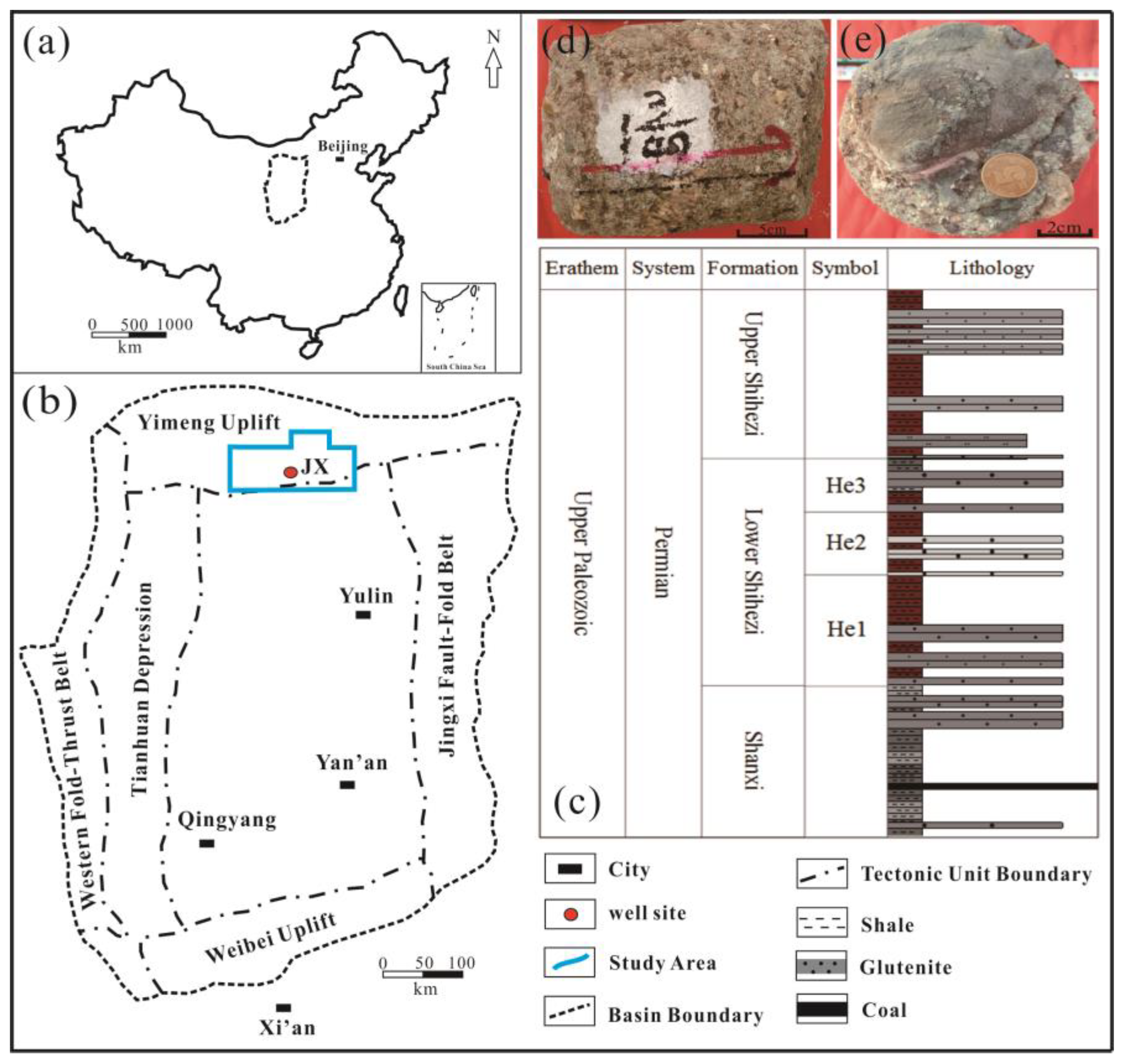
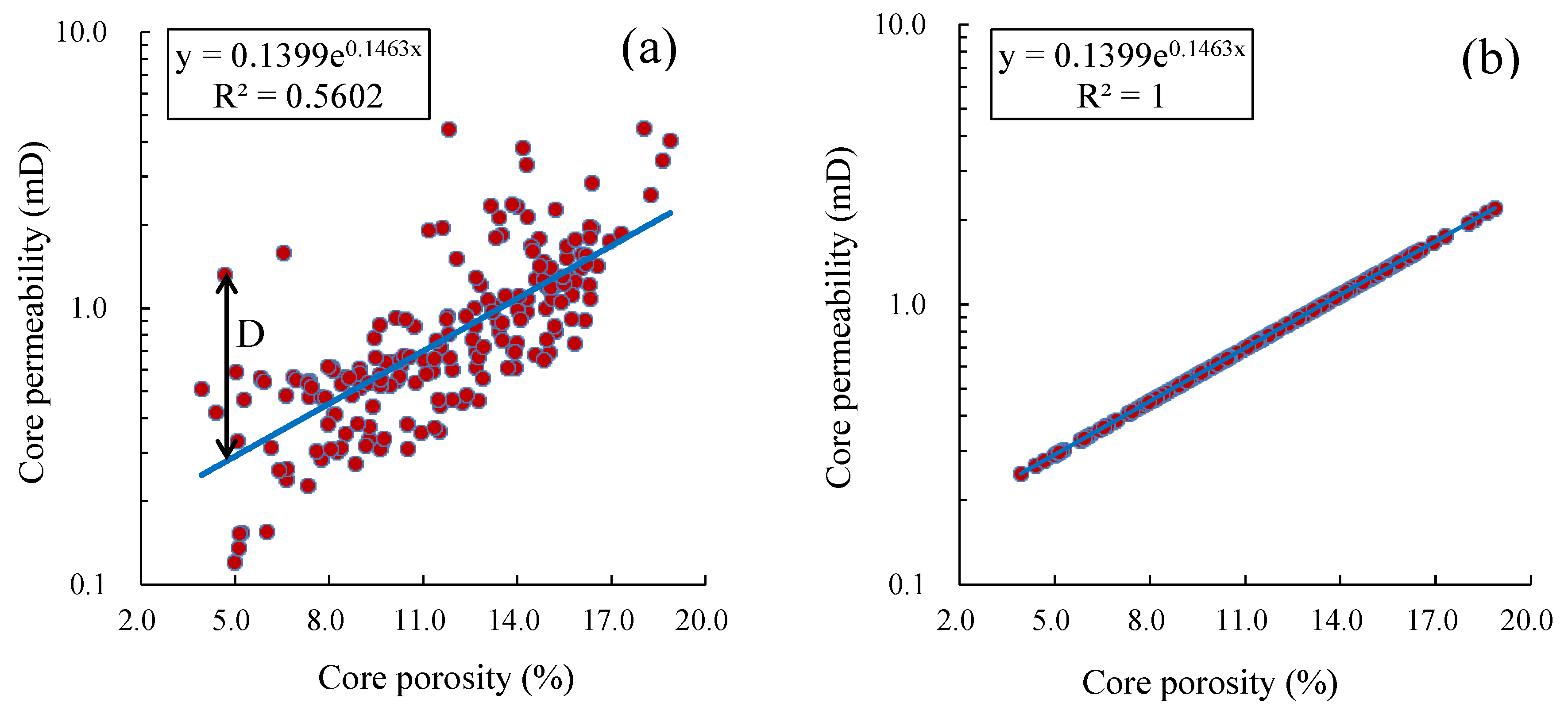
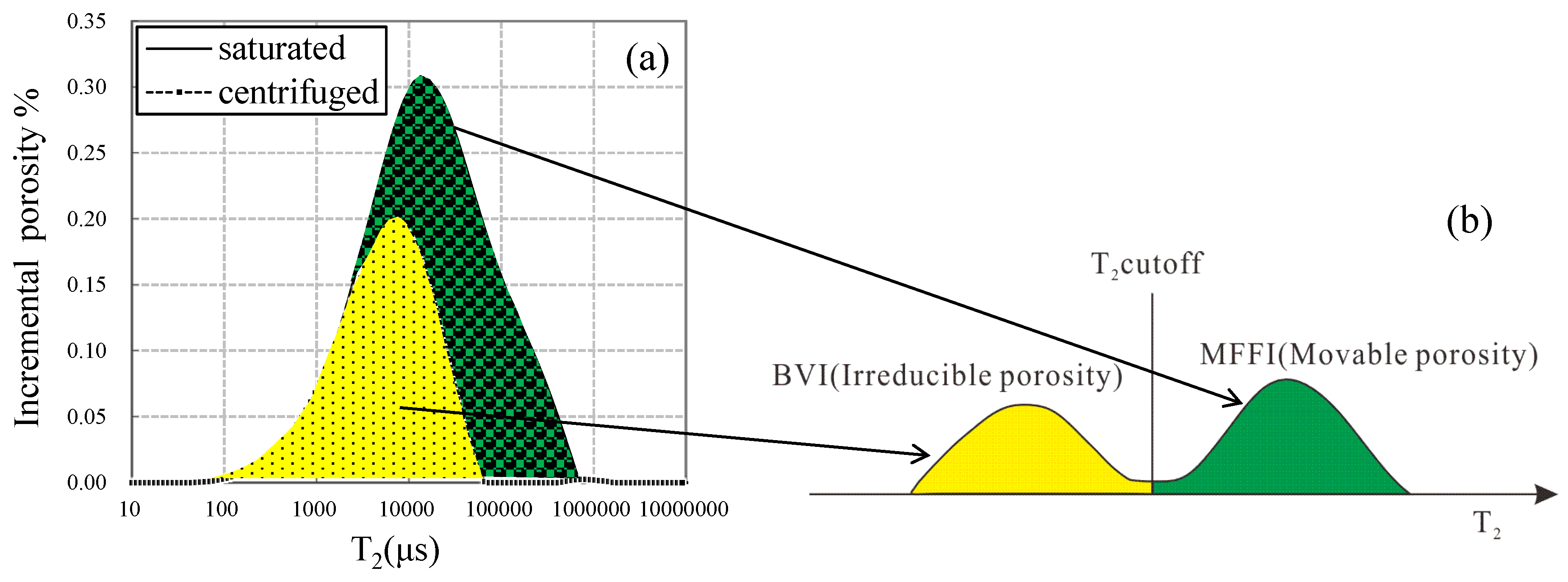
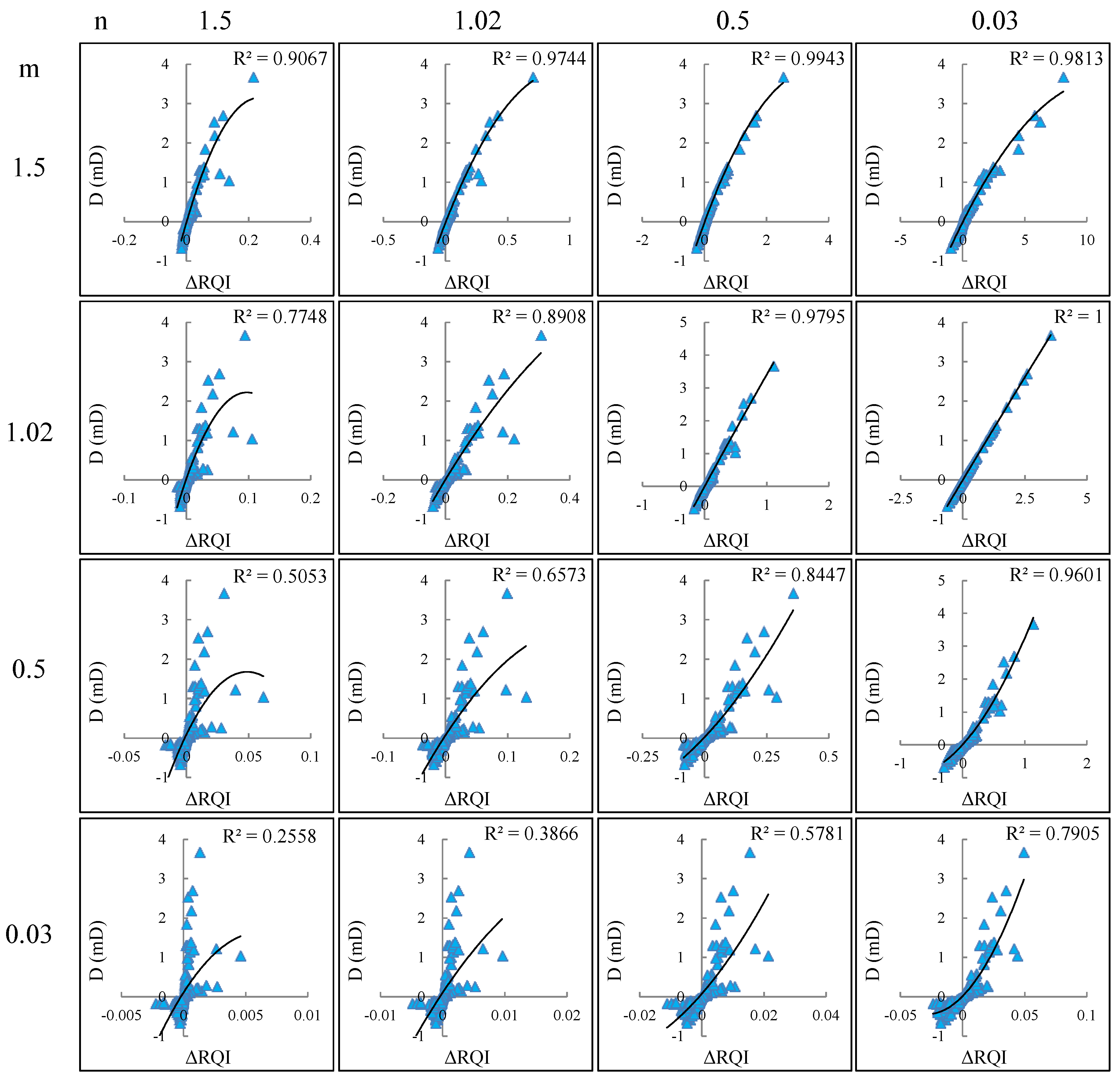
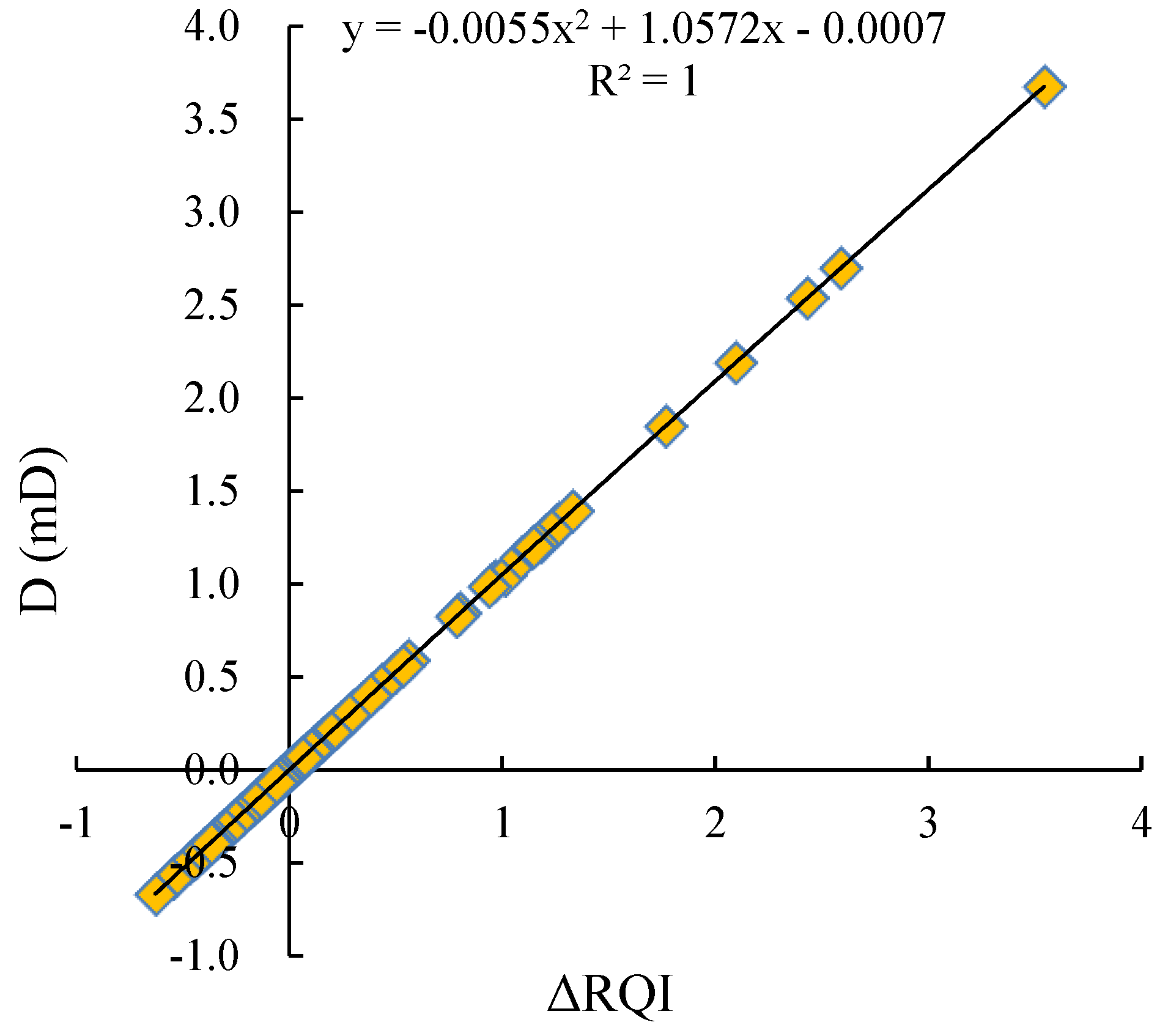
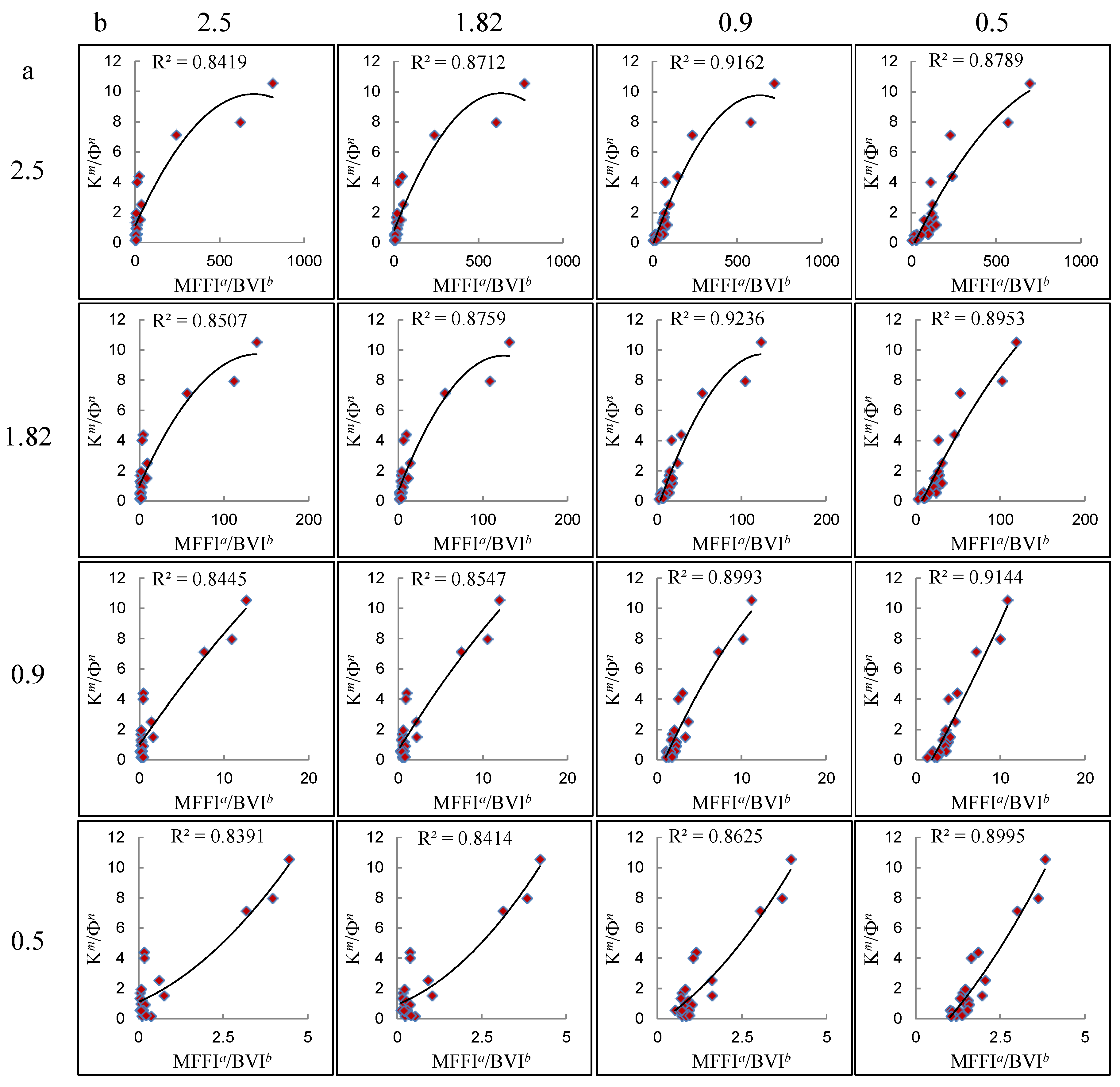
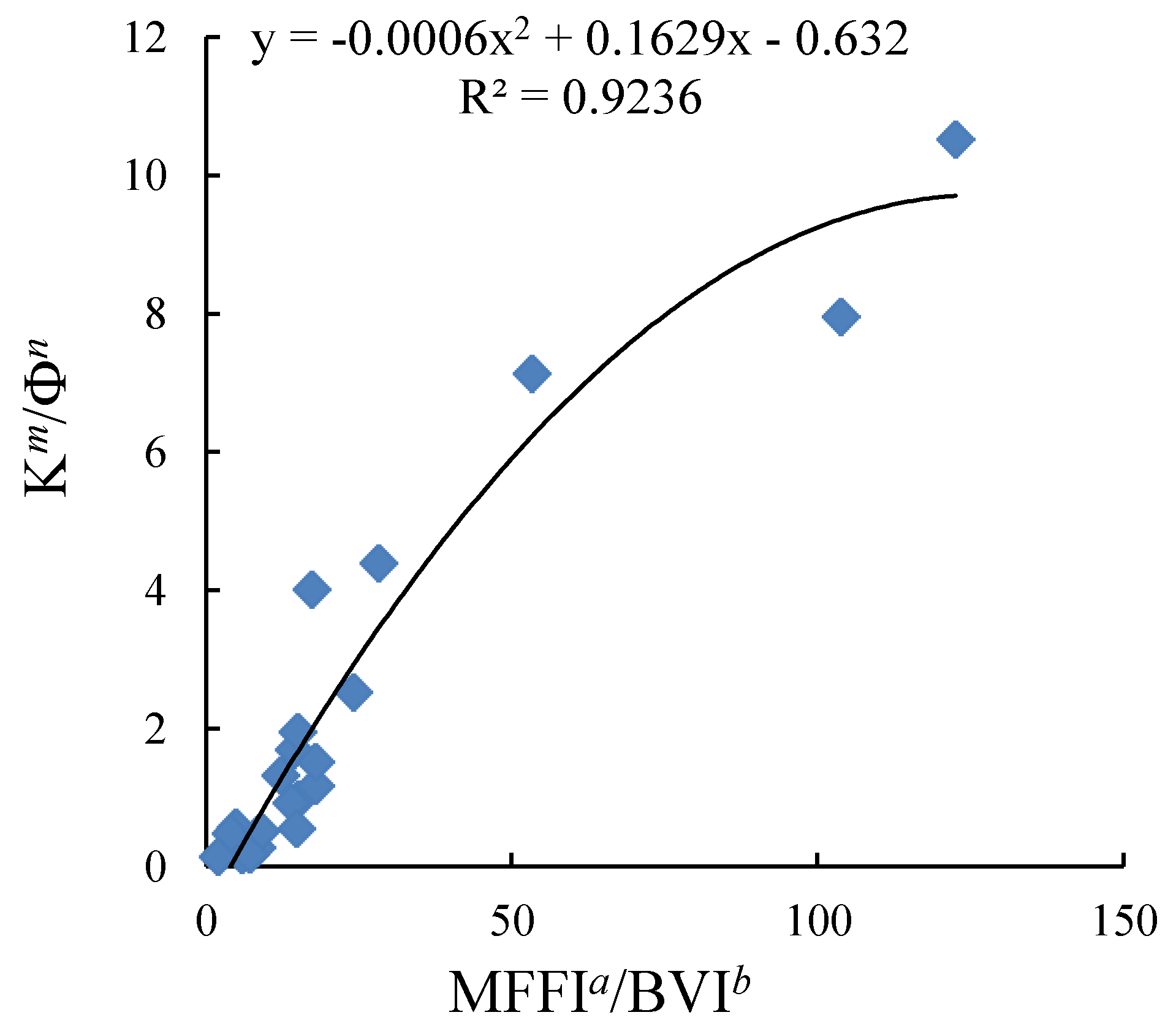
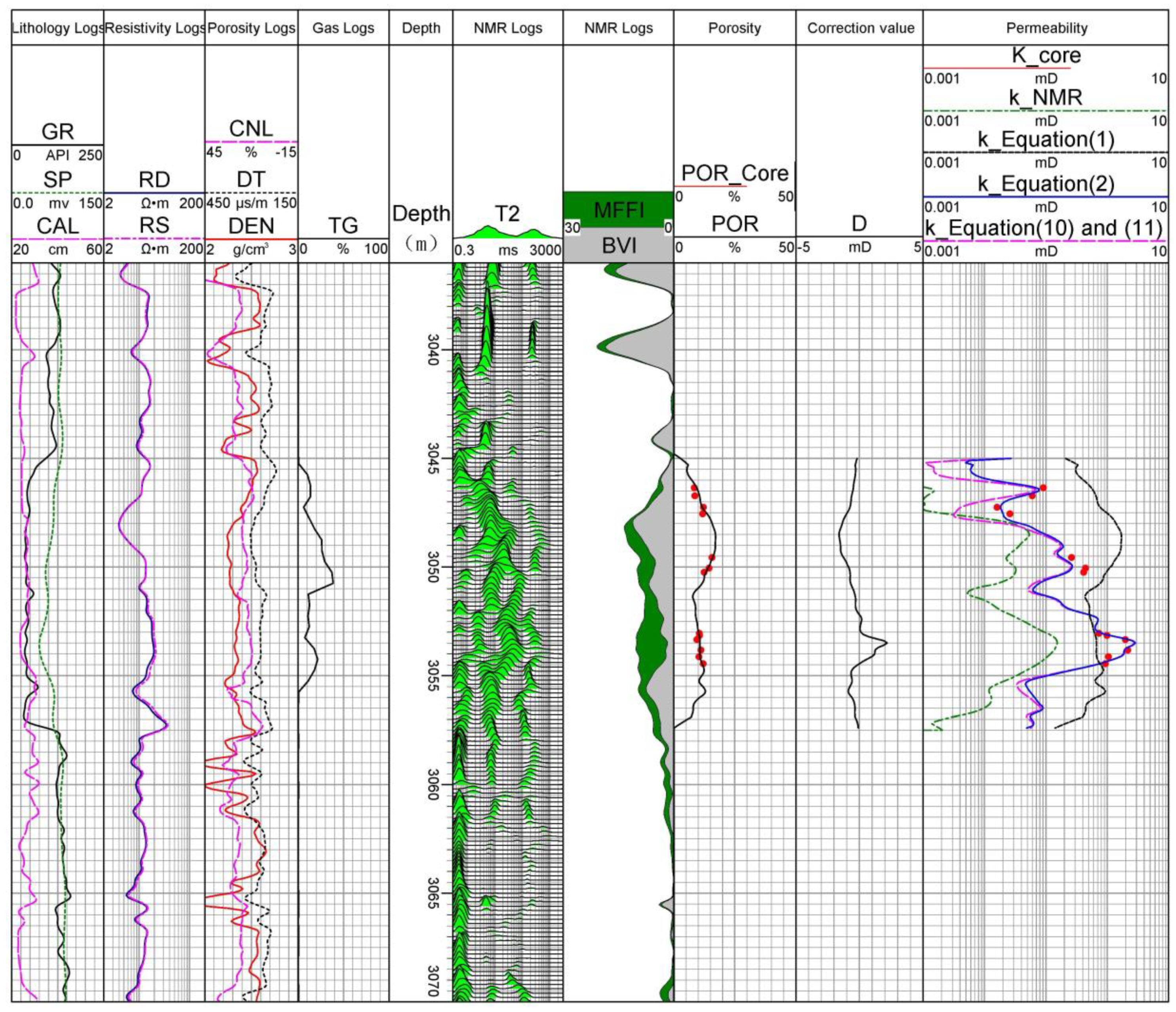
| No. | Φ-Helium | K-Helium | Φ-NMR | Swi | T2cutoff | MFFI | BVI |
|---|---|---|---|---|---|---|---|
| (%) | (mD) | (%) | (%) | (ms) | (%) | (%) | |
| 1 | 10.8 | 0.620 | 10.6 | 49.1 | 14.28 | 5.5 | 5.3 |
| 2 | 15.1 | 1.819 | 14.6 | 34.4 | 14.60 | 9.9 | 5.2 |
| 3 | 13.4 | 2.080 | 13.2 | 31.9 | 18.51 | 9.1 | 4.3 |
| 4 | 14.1 | 1.423 | 13.9 | 36.6 | 13.34 | 8.9 | 5.2 |
| 5 | 13.9 | 1.054 | 13.4 | 32.2 | 9.66 | 9.4 | 4.5 |
| 6 | 13.7 | 1.269 | 13.5 | 29.0 | 11.03 | 9.7 | 4.0 |
| 7 | 15.4 | 4.625 | 14.7 | 22.8 | 9.50 | 11.9 | 3.5 |
| 8 | 11.7 | 4.195 | 11.4 | 26.9 | 11.68 | 8.5 | 3.2 |
| 9 | 8.4 | 0.195 | 8.2 | 41.5 | 14.22 | 4.9 | 3.5 |
| 10 | 10.3 | 0.992 | 10.1 | 28.7 | 7.05 | 7.3 | 3.0 |
| 11 | 7.2 | 0.522 | 7.1 | 46.0 | 13.08 | 3.9 | 3.3 |
| 12 | 11.9 | 0.606 | 11.5 | 29.9 | 15.25 | 8.3 | 3.6 |
| 13 | 8.6 | 0.306 | 8.2 | 34.8 | 6.10 | 5.6 | 3.0 |
| 14 | 11.1 | 0.565 | 10.9 | 38.2 | 8.77 | 6.9 | 4.2 |
| 15 | 3.3 | 0.161 | 3.5 | 47.8 | 7.27 | 1.7 | 1.6 |
| 16 | 9.8 | 2.656 | 9.6 | 19.2 | 22.92 | 7.9 | 1.9 |
| 17 | 7.8 | 1.600 | 7.8 | 20.7 | 14.48 | 6.2 | 1.6 |
| 18 | 7.5 | 0.206 | 7.0 | 35.0 | 15.04 | 4.9 | 2.6 |
| 19 | 15.3 | 10.879 | 14.5 | 6.4 | 22.59 | 14.3 | 1.0 |
| 20 | 13.8 | 8.250 | 13.5 | 7.1 | 19.75 | 12.8 | 1.0 |
| 21 | 10.4 | 7.350 | 9.7 | 10.0 | 16.38 | 9.4 | 1.0 |
| Type | Equation | a | b | R2 |
|---|---|---|---|---|
| Polynomial | y = −0.0006x2 + 0.1629x − 0.632 | 1.82 | 0.90 | 0.9236 |
| Linear | y = 7.0798x − 8.7781 | 0.35 | 0.26 | 0.8874 |
| Logarithmic | y = 18.464ln(x) − 1.3917 | 0.20 | 0.19 | 0.8440 |
| Power | y = 0.0397x1.2803 | 1.70 | 0.70 | 0.8169 |
| Exponential | y = 0.0666e0.5298x | 0.90 | 0.16 | 0.8019 |
| No. | Depth | K_core | K_NMR | K_Equation (1) | K_Equation (2) | K_Equations (10) and (11) |
|---|---|---|---|---|---|---|
| (m) | (mD) | (mD) | (mD) | (mD) | (mD) | |
| 1 | 3046.35 | 0.0910 | 0.0014 | 0.5776 | 0.0797 | 0.0789 |
| 2 | 3046.72 | 0.0604 | 0.0012 | 0.6603 | 0.0421 | 0.0402 |
| 3 | 3047.25 | 0.0162 | 0.0010 | 0.7973 | 0.0232 | 0.0042 |
| 4 | 3047.55 | 0.0261 | 0.0035 | 1.0892 | 0.0190 | 0.0029 |
| 5 | 3049.56 | 0.2625 | 0.0246 | 1.3989 | 0.1892 | 0.1615 |
| 6 | 3050.05 | 0.4431 | 0.0325 | 1.0486 | 0.2690 | 0.2570 |
| 7 | 3050.24 | 0.4130 | 0.0323 | 0.9896 | 0.2368 | 0.2233 |
| 8 | 3053.05 | 0.7330 | 0.1245 | 0.6313 | 0.9260 | 0.9357 |
| 9 | 3053.15 | 0.9921 | 0.1216 | 0.6466 | 1.3298 | 1.3375 |
| 10 | 3053.34 | 1.9752 | 0.1247 | 0.6533 | 1.9686 | 1.9826 |
| 11 | 3053.82 | 2.1580 | 0.1490 | 0.6651 | 1.9212 | 1.9340 |
| 12 | 3054.13 | 1.0473 | 0.1088 | 0.6589 | 1.7083 | 1.7154 |
| 13 | 3054.45 | 0.9310 | 0.0806 | 0.7757 | 0.6505 | 0.6550 |
| Correlation coefficient | 0.8959 | 0.4019 | 0.9419 | 0.9418 | ||
© 2019 by the authors. Licensee MDPI, Basel, Switzerland. This article is an open access article distributed under the terms and conditions of the Creative Commons Attribution (CC BY) license (http://creativecommons.org/licenses/by/4.0/).
Share and Cite
Liu, L.; Pan, H.; Deng, C.; Huang, G. A Method for Improving Permeability Accuracy of Tight Sandstone Gas Reservoirs Based on Core Data and NMR Logs. Energies 2019, 12, 2859. https://doi.org/10.3390/en12152859
Liu L, Pan H, Deng C, Huang G. A Method for Improving Permeability Accuracy of Tight Sandstone Gas Reservoirs Based on Core Data and NMR Logs. Energies. 2019; 12(15):2859. https://doi.org/10.3390/en12152859
Chicago/Turabian StyleLiu, Liang, Heping Pan, Chengxiang Deng, and Guoshu Huang. 2019. "A Method for Improving Permeability Accuracy of Tight Sandstone Gas Reservoirs Based on Core Data and NMR Logs" Energies 12, no. 15: 2859. https://doi.org/10.3390/en12152859
APA StyleLiu, L., Pan, H., Deng, C., & Huang, G. (2019). A Method for Improving Permeability Accuracy of Tight Sandstone Gas Reservoirs Based on Core Data and NMR Logs. Energies, 12(15), 2859. https://doi.org/10.3390/en12152859






